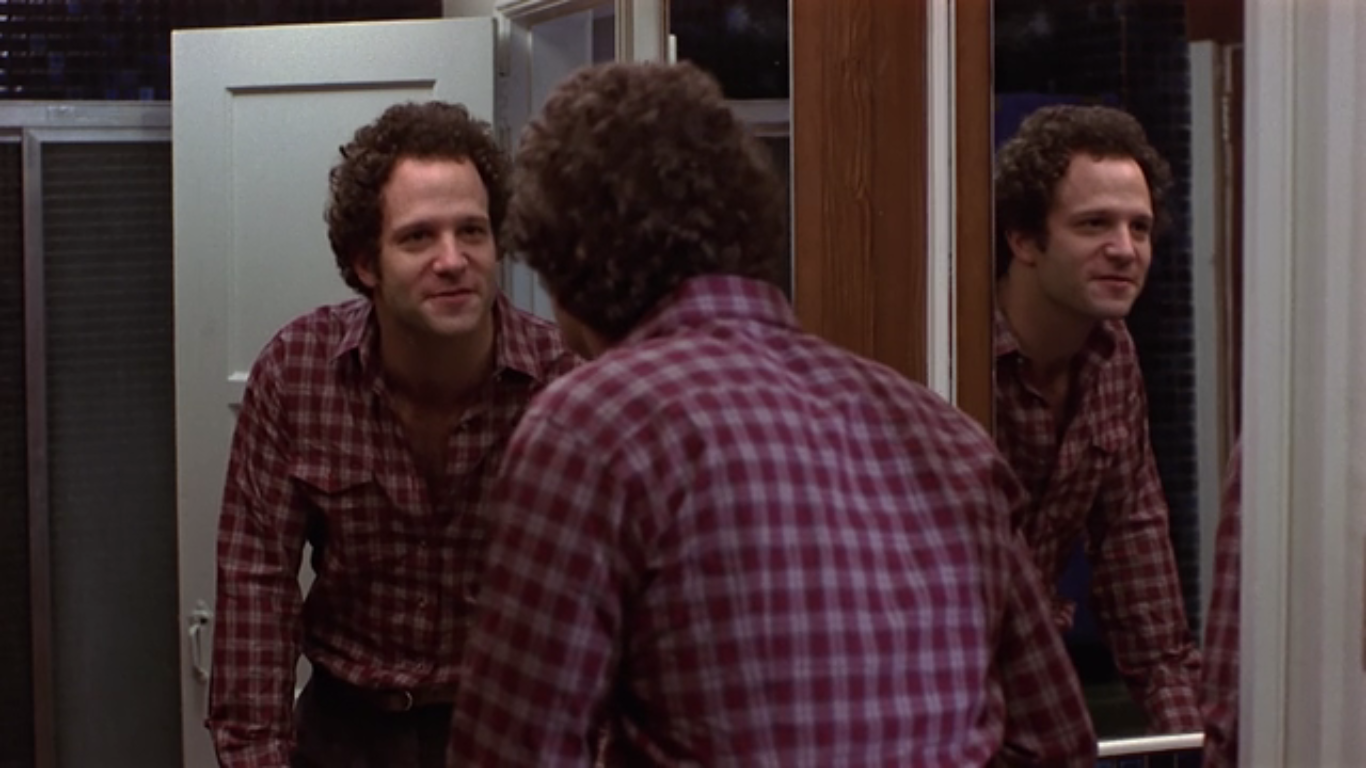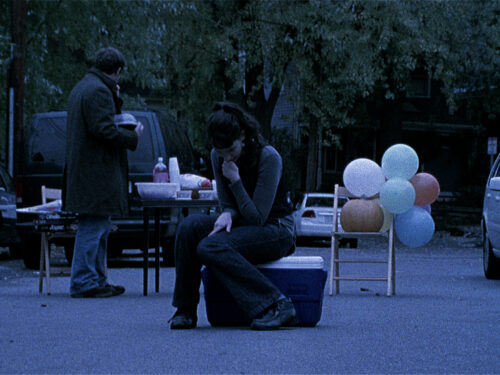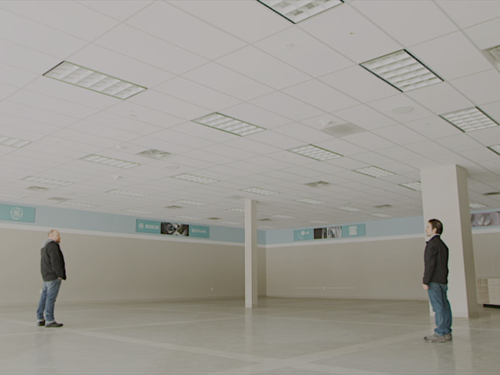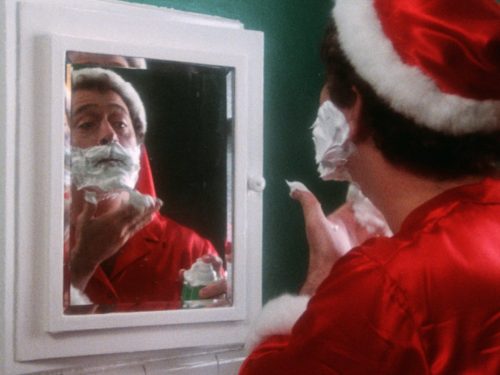From the formation of his ‘Albert Brooks’ persona through to his first films, Real Life and Modern Romance, Brett Wright examines the early career of one of America’s greatest living comedians
Just before Thanksgiving in 1982, Albert Brooks was in New York trying to acquire funding for what would become his 1985 feature film Lost in America. ABC Motion Pictures turned down his script and pulled funding because it wasn’t “sufficiently commercial” (Slansky 1983) right before he appeared on The Late Show with David Letterman. Between rapid-fire jokes about bowling and airplane travel, Brooks managed to weave in cutting remarks about the process of studio filmmaking in America. When Letterman asked about securing financing, Brooks responded with barely concealed vitriol:
“It’s getting into the crap. It’s big business. I don’t belong there, but I have to be funny so I can get the money and go back and [make the film] … I’m not a teamster but lord knows I want to pay them everything they want … You don’t want to turn on your pipes and see your grandma’s blood come through — although Columbia will listen to this and go, ‘There’s our fall hit: Grandma Blood!’”
Brooks’ relationship to the Hollywood money-go-round may seem an uncomfortable fit, but as far as his comedy goes, he does, in fact, belong there. While receiving nearly universal acclaim as an actor in major studio projects (1987’s Broadcast News, 2003’s Finding Nemo), as a filmmaker himself, Brooks is often spoken of like some sort of maverick outsider who made it inside Hollywood’s gates — a Trojan horse armed not with sword and shield, but with a ventriloquist dummy and self-awareness. But he was born inside the gates and has remained there for his entire career.
The most important aspect of Albert Brooks as a comedic persona and as a filmmaker is that he is entirely of the system he has been satirizing his entire life. It is the very tension relating to the business of being funny that drives his best comedy. Throughout his career, he has skewered his industry from every angle: He has done fake infomercials for a comedy school, offering anyone with a bank account the chance to learn a proper spit-take; his second comedy record is a concept album titled A Star is Bought (1975); in his films, he commonly plays a fictionalized version of himself as a disgruntled entertainer or writer; the narratives of which often include crucial scenes of characters “pitching” themselves like products to producer-like figures. To Brooks, the commercial backbone of entertainment is not some harsher, more concrete reality behind the dreamworld on screen; it is a social structure that creates fantastically unreal and dehumanizing pressures for its members and incites outlandish delusions for the entertainer and audience alike. His work demonstrates a split-sided desire for stirring up ideological clashes with the powers-that-be and a cautiousness in the way he smoothes over the rifts he creates, using traditional entertainment conventions to rein himself back in.
What follows aims to trace these conflicting impulses in Brooks’ three early films. In Real Life (1979), Modern Romance (1981) and Lost in America (1985), his style pushes against the boundaries of traditional Hollywood filmmaking. His performances in these films are fraught with a self-lacerating desire to understand what drives an entertainer’s need to be the center of attention, while showing an uncertainty in how far his intelligence and honesty can go when actually in the spotlight.
But first, let’s look at his beginnings. Part one of this essay explores his childhood growing up as a literal punchline, through to his years as a stand-up comedian and his early film career. Part two focuses on his most commercially successful film, Lost in America. It will also pay particular attention to how Brooks ends his first three films, for their conclusions are caught in a strange and fascinating bind between giving the people what (the studios think) they want and a desire to disrupt the neat and tidy notion of a Hollywood ending. We will see how Brooks’ self-reflexive comedies are about more severe problems than how the world is deceived by the fantasies produced in Tinseltown. For an artist so enmeshed in the codes and the craft of show business, each of these films offer personal insights into the very real struggles of his own life as a working performer whose act never really shuts off.
A Star is Born: The Beginnings of the “Albert Brooks Persona”
Brooks’ roots in show business were planted at birth. His mother, Thelma Leeds, was a successful actress and singer. His father, Harry Einstein, was a popular radio comedian who went by the stage-name Parkyakarkus. Like his third son, Harry’s comedy act carried over into real life, and when this child was born in Los Angeles on July 22, 1947, he couldn’t resist naming him Albert.
Young Albert Einstein took the name and ran with it, playing class clown from a very early age. He developed a renowned sense of comic timing by age 15. At Beverly Hills High School he became close friends with other show business offspring such as Rob Reiner. He quickly formed an insider view of the world of entertainment, and his jokes began revolving around the façade of performers. One of his first routines was an impression of master escape artist Harry Houdini being unable to open a simple screen door to make an entrance. After witnessing this act in his living room, Carl Reiner was compelled to mention 16-year-old Albert’s name on The Tonight Show as one of the funniest people he had ever seen (Zoglin 2008, 109-110). Before graduating high school, the comedy elite of Hollywood were praising the name Albert Einstein.
Around the time he turned 19, Albert changed his last name to Brooks when he tried to start a dramatic acting career. He had little success. Through the Reiners, he was able to obtain a manager and appear on The Steve Allen Show in 1968 where he debuted comedy bits like “Danny and Dave,” a routine in which Brooks plays the world’s worst ventriloquist, moving his mouth more than the dummy’s and dropping him to the ground in order to smoke a cigarette onstage.
Based on the success of such routines, Brooks was given unprecedented freedom on television. Producers granted him nearly complete creative control to do whatever he wanted in front of the camera. At this point, he had never even performed live in a club. Highlights of his act included a shadow artist with a broken hand, reduced to a single impression of a rabbit hiding behind a rock, and a mime who talks the crowd through his act in faux French (Slanksy 1983). As author Richard Zoglin writes in his profile on Brooks in Comedy at the Edge, “Some dubbed it post-comedy … He was making fun of how show business had infected all of us, creating a world of amateurs and wannabes so desperate for applause that they could barrel through any kind of inanity” (114). Brooks’ act could be considered a halfway point between the crowd-pleasing antics of Steve Martin and the more challenging ‘is this even a joke?’ performances of Andy Kaufman. Like Kaufman, his bits existed in some strange alternate universe where hacks could get on live television and tell jokes that most people would be embarrassed to rehearse in their mirrors. Never one to pander, Brooks trusted his audience to follow along and join him in his unique parody. His jokes depended on this, for what is an entertainer without an audience? Brooks crucially recognized that audiences are just as needy in their desire for escape through entertainment as the entertainer is for their attention.
During an anxiety-ridden period of touring in the mid-seventies, Brooks recorded Comedy Minus One (1973), his first album. He would eventually retreat entirely into the studio to make 1975’s A Star is Bought, in which his persona applies his voice to as many pop music styles as possible, hoping one will lead to commercial success. Brooks’ concept of the audience being a part of the joke reached its zenith on the interactive final track of Comedy Minus One. Brooks plays the straight man in a two-person routine with the listener, who reads all the punch-lines from a script included on the record jacket. As the routine plays out, Brooks says his line before allowing a stretch of room noise for the listener to fill in the punchline, which is followed by the recorded audience’s response. To hear this track without participating makes for an experience some would call avant-garde — a series of painfully conventional joke setups with an audience laughing at silent punchlines. The humor comes not from the jokes themselves, but in getting the audience to follow such a banal and schlocky schematic. This was exactly what inspired Lorne Michaels to offer Brooks the host position on his new late-night sketch show called Saturday Night in 1975. Brooks turned down his offer, advising Michaels to have rotating guest hosts (Zoglin, 120). Instead he requested to make short films remotely from Los Angeles, pioneering the pre-recorded format (with much help and guidance behind the camera from filmmaker Penelope Spheeris) for what would later become SNL’s Digital Shorts.
In the short films, Brooks often played himself, or what came to be referred to as ‘The Albert Brooks Persona,’ in all of his narcissistic glory. In the most famous of the six films he made for Saturday Night he gets the opportunity, due to his celebrity status, to perform open-heart surgery on one of his fans. He documents the occasion with interviews of himself and a self-important voice-over narration. Zoglin says, “It was Brooks’ most acid commentary yet on our obsession with celebrity — and on himself, the stand-up comedian as diva, neurotic and big baby” (121). His creative relationship with Michaels ended soon after on terrible terms, bringing an abrupt stop to his days making short films. But Brooks would carry the style he developed at Saturday Night directly into his first feature, Real Life.
All About Albert: The First Two Films
Real Life and Modern Romance must have been recognized as strange sells for mainstream audiences. The brilliant not-quite-3D trailer for Real Life alone had to have left most unsuspecting entertainment seekers scratching their heads. With Monica Johnson (his most frequent collaborator) and Harry Shearer, Brooks wrote Real Life as a send-up of the PBS documentary series An American Family (1973). An example of proto-reality television, Brooks saw the show, and its ambitions for “realism,” as ripe for satire. As his first directorial effort, Brooks put on the ‘Albert Brooks persona’ to play the director of a production documenting the everyday lives of the Yeager family from Phoenix. The mock documentary style plays to Brooks’ standup strengths as he essentially performs extended monologues into the camera in his characteristically narcissistic manner. In the film, Albert says he wants to make a film that is true to life but will also hold an audience “spellbound.” Of course, his truth-seeking ambitions are continually counteracted by his desire for drama, while his promise for unaltered naturalism is disrupted by the presence of the invasive — and expensive — cyborg-like cameras tracking the Yeager family’s every movement. He modestly sees the potential for his project to not only win an Oscar, but maybe a Nobel Prize as well.
The Yeagers try to appear as “normal” as possible while Albert’s manipulations intensify. This leads to Mrs. Yeager (Frances Lee McCain) developing a crush on him. Then tragedy strikes when Mr. Yeager (Charles Grodin), a veterinarian, accidentally anesthetizes a horse to death on camera. As the family grows concerned over how much the experience has altered their reality, and at the urgings of the scientists the studio has hired to bring credibility to the project, Albert’s producers step in to wrest the film away from him. He subsequently suffers a mental breakdown and, finding inspiration in Gone with the Wind, finishes his film by lighting the Yeager’s home on fire while dressed as a clown. Recognized retroactively as a classic, Real Life was far from a commercial success.
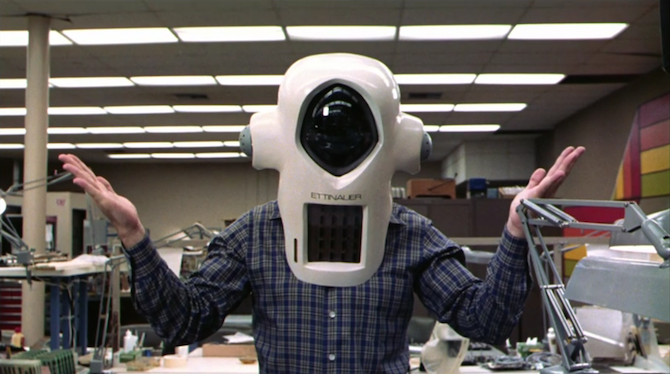
Rather than dialing back into more crowd-pleasing material, Brooks dug deeper into his neuroses for Modern Romance. He plays Robert Cole, a B-movie editor who is in love with Mary Harvard (Kathryn Harrold, Brooks’ real-life girlfriend at the time). He routinely breaks up with her only to come running back days later. In dealing with this on-again/off-again relationship, Modern Romance relies more on its actors’ performances than the meta setpieces of Brooks’ previous film work. For the first time Brooks was able to show more of his range as an actor. Where Real Life, his short films and stand-up exaggerate the phoniness of his showbiz persona, Modern Romance is striking for the way Brooks removes the camera crews and audience to show Robert putting on a performance mostly for himself. Brooks substitutes the talking-into-the-camera monologues for extended scenes in which his character mugs into mirrors and makes witty asides to himself when he is alone. Brooks uses longer takes in many scenes, notably when Robert downs some Quaaludes following his split from Mary. The scene is unrelenting in its depiction of his tiresome personality, as he bounces erratically between moaning and groaning about how miserable he is one minute to pathetically attempting self-reassurance the next.
Robert is desperately reliant on routines to bring structure to his life, but he is unwilling to fully commit himself to anything. After his breakup, Robert seeks out tried-and-true systems geared toward new beginnings. He sets himself on a health and fitness initiative. He buys the supplies and dresses the part, but quits when he doesn’t like the actual working out portion. He reenters the dating world but calls off his first date within minutes of picking the woman up to go running back to Mary.
Similarly, Brooks plays Robert as an emotional huckster in the way he refurbishes his relationship with Mary. Robert believes he must find the “perfect person” to be his lover. Mary wisely voices concerns that Robert’s idea of love is “movie love,” one involving romantic highs during courtship and leaving when things begin to settle. Like his stand-up persona, the one who wore the plaid suits and utilized classic comedy props, Robert nails the generic, surface aspects of love without mastering the routine. He thrives at the romance part — buying her stuffed animals to accompany apologies, telling her how beautiful she is, taking her on secluded getaways — without investing in the more crucial aspects of trust, compromise and commitment that keep a relationship together. Through Brooks’ performance, Modern Romance traces an egotism that is more contradictory, maddening and insecure than any of Brooks’ other characters.
****
By far his most personal work, Modern Romance garnered considerable acclaim, notably from Stanley Kubrick, who praised Brooks’ depiction of jealousy and romantic obsession. It is a common opinion that Modern Romance marks the peak of Brooks’ film career. Zoglin epitomizes the common reasoning that after Real Life and Modern Romance, Brooks’ career “tapered off with a string of often very funny but progressively more conventional comedies” (124). Yet this tendency to heap praise upon his earliest films and discredit his subsequent work for their conventionality misses a crucial part of Brooks’ sensibility. It also allows for a critical discussion of certain limitations that are inherent to Brooks’ self-reflexive style.
As far as studio filmmaking goes, Brooks’ first two films were both well ahead of their time. He experimented with the unfamiliar form of a mockumentary before the term existed (Real Life was released five years before friend Rob Reiner’s This is Spinal Tap in 1984) and made an aggressively unsentimental romantic comedy about obsessive behavior.
But it should be noted that by the time Brooks had released Real Life, other narrative films had broken similar ground in more daring ways. Jim McBride had made David Holzman’s Diary (1967), a fictional documentary depicting a film-obsessed neurotic seeking truth by filming his every move. Holzman’s Diary avoids outrageous comedy in favor of a more subtle sense of humor. Holzman monologues into his camera and allows his obsessive faith in cinematic truth to ruin his relationship with his girlfriend, whom he takes advantage of and spies on with his camera. Where Real Life gets caught up in its meta-conceptual flares, the satire of Holzman’s Diary works toward a more caustic vision of how a camera fuels its characters’ isolating narcissism.
Perhaps most relevant are the films made by fellow comedian-turned-filmmaker Elaine May, who had already made A New Leaf (1971), The Heartbreak Kid (1972) and Mikey and Nicky (1976). Comparisons have often been drawn between her work and Brooks’, not just for their shared background as performers, but for their thematic concerns. Like Brooks, May has a keen eye for that particular hunger for a spotlight — that blessing and a curse for most performers, where it doesn’t matter how small the bulb may be or how low one has to stoop to get within its halo, they are going to play their scene and turn some heads. Her films feature male characters with a great deal in common with Brooks’ protagonists, particularly Robert in Modern Romance. May’s depictions of her self-centered, neurotic and narcissistic men are not just abrasive, but sweaty, ugly, pained, vulnerable and unstable in ways that plunge through to their spiritual core. Even as self-critical as Modern Romance can be, Brooks’ films rarely tip into the truly dangerous territory that May battled studios to reach for in her work. Charles Grodin’s character in The Heartbreak Kid isn’t just phony or shallow, but hollow, filling himself in with whatever traits are necessary to his pursuit of a new relationship during his own honeymoon. In Mikey and Nicky, small time gangsters harbor long-standing grudges and jealousies, as their egos flare up and burnout in disturbing and childish displays of emotional violence.
Related: Showing Off: Elaine May’s Mikey and Nicky (1976) by Brett Wright
The most crucial distinction separating David Holzman’s Diary and May’s work from Brooks’ is that they avoid turning their figures into clowns in the way Brooks does. May’s films in particular dare to take an extra slippery step into the murkiest corners of her characters’ self-deceptions, pushing through the smoke and mirrors of their acts to make contact with inner, emotional lives, a move that Brooks’ style of meta-comedy is built to guard itself from taking. Many of his jokes revolve around characters causing a fuss and then avoiding serious confrontation. Where May’s humor brings a density to the drama, Brooks’ humor lightens — at times it may frustrate, but it rarely provokes. This leaves the films pointing to the flaws in his characters, or the shallowness of a situation, without really challenging his audience to see more than the selfishness or buffoonery. With his personality so enmeshed with the personas onscreen, his approach is more self-defeating than self-critical. It is much easier to turn complicated insecurities and problems of identity into defeatist punchlines than it is to really question them. By making himself the biggest joke, Brooks’ self-aware comedy routinely turns into a form of self-defense when he is clearly capable of looking under the armor.
Hollywood Endings Pt. 2: Albert Brooks and ‘Lost In America’ is available here
Follow Brett and Split Tooth Media on Twitter
Stream Real Life here, or purchase it on DVD here
Stream Modern Romance here, or purchase it on Blu-ray here
(Split Tooth may earn a commission from purchases made through affiliate links on our site.)

